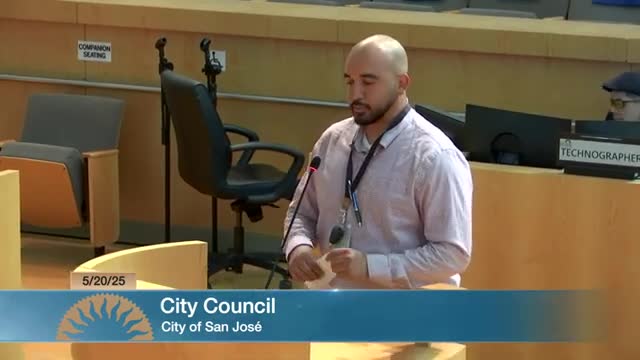San Jose city employees advocate against return to office mandate citing family needs and flexibility
May 20, 2025 | San Jose , Santa Clara County, California
This article was created by AI summarizing key points discussed. AI makes mistakes, so for full details and context, please refer to the video of the full meeting. Please report any errors so we can fix them. Report an error »

In a recent San Jose City Council meeting, city employees voiced strong concerns regarding a proposed return-to-office policy that would require them to work four days a week in the office. The discussions highlighted the significant impact this change could have on employees' work-life balance, productivity, and overall morale.
Several employees, including Nicole Ricksucker from the Environmental Services Department, emphasized the benefits of the current hybrid work model, which allows for flexibility that many workers rely on to manage personal responsibilities, such as childcare and family care. Ricksucker noted that the ability to work from home has not only improved her productivity but also provided essential support for her family during challenging times, including custody battles.
Anne Bayless, also from Environmental Services, urged the council to delay the implementation of the new policy until proper negotiations with the union could take place. She stressed that the proposed changes could disrupt the lives of workers who are already balancing demanding roles with family obligations. Bayless shared her experience of managing work responsibilities while caring for sick children, illustrating the need for flexibility in the workplace.
Other employees echoed these sentiments, with many expressing fears that the new policy could lead to increased turnover and a loss of institutional knowledge. Jill Mariani, a recent returnee from maternity leave, highlighted the financial strain that the new policy could impose on families needing to adjust childcare arrangements, further complicating their ability to work effectively.
Michael John, a senior development officer, criticized the lack of data supporting the shift to a four-day in-office requirement, arguing that the current three-day model already provides sufficient collaboration opportunities while allowing employees to focus on their tasks. He warned that the proposed changes could harm productivity and employee retention.
The meeting underscored a growing tension between city management and employees regarding workplace policies. As the council considers the feedback from its workforce, the implications of these discussions extend beyond individual employees, potentially affecting the city's ability to attract and retain talent in a competitive job market.
In conclusion, the city council faces a critical decision that could reshape the work environment for its employees. As discussions continue, the need for a balanced approach that respects both operational needs and employee well-being remains paramount. The council is expected to revisit this issue in upcoming sessions, with many employees hopeful for a resolution that acknowledges their concerns.
Several employees, including Nicole Ricksucker from the Environmental Services Department, emphasized the benefits of the current hybrid work model, which allows for flexibility that many workers rely on to manage personal responsibilities, such as childcare and family care. Ricksucker noted that the ability to work from home has not only improved her productivity but also provided essential support for her family during challenging times, including custody battles.
Anne Bayless, also from Environmental Services, urged the council to delay the implementation of the new policy until proper negotiations with the union could take place. She stressed that the proposed changes could disrupt the lives of workers who are already balancing demanding roles with family obligations. Bayless shared her experience of managing work responsibilities while caring for sick children, illustrating the need for flexibility in the workplace.
Other employees echoed these sentiments, with many expressing fears that the new policy could lead to increased turnover and a loss of institutional knowledge. Jill Mariani, a recent returnee from maternity leave, highlighted the financial strain that the new policy could impose on families needing to adjust childcare arrangements, further complicating their ability to work effectively.
Michael John, a senior development officer, criticized the lack of data supporting the shift to a four-day in-office requirement, arguing that the current three-day model already provides sufficient collaboration opportunities while allowing employees to focus on their tasks. He warned that the proposed changes could harm productivity and employee retention.
The meeting underscored a growing tension between city management and employees regarding workplace policies. As the council considers the feedback from its workforce, the implications of these discussions extend beyond individual employees, potentially affecting the city's ability to attract and retain talent in a competitive job market.
In conclusion, the city council faces a critical decision that could reshape the work environment for its employees. As discussions continue, the need for a balanced approach that respects both operational needs and employee well-being remains paramount. The council is expected to revisit this issue in upcoming sessions, with many employees hopeful for a resolution that acknowledges their concerns.
View full meeting
This article is based on a recent meeting—watch the full video and explore the complete transcript for deeper insights into the discussion.
View full meeting
